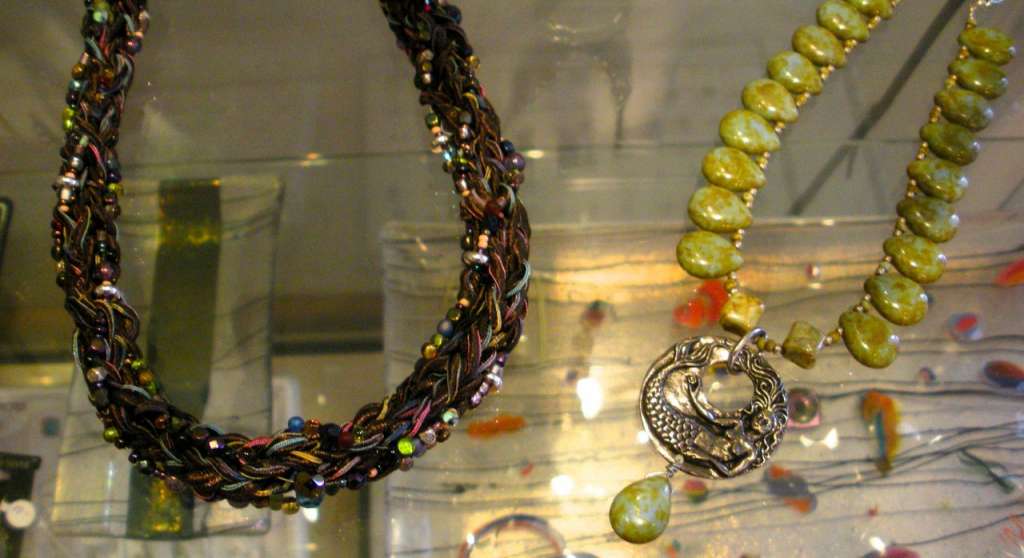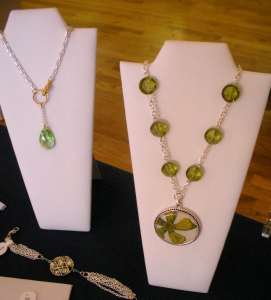August 30, 2014 | Posted in CRAFTING BUSINESS | By sockii
Issues and Factors to Consider when Determining How to Price Your Crafts
This is the fourth article in my series on becoming a craft show vendor, focusing on pricing your crafts to sell. Previous articles have examined (1) determining if being a craft vendor is right for you, (2) designing your display space with necessary fixtures and materials, and (3) finding craft markets in your area. Assuming you’ve got some shows now lined up to work, you need to decide how you will price your items.
Pricing can be a tricky business, and a definite balancing act especially for beginning craft vendors. You need to set your prices high enough that you get what you feel your work is honestly worth, yet not price yourself out of what can be a highly competitive market. Price your merchandise too low, and customers may be skeptical about the quality of your merchandise as well.
There are many factors to consider in setting your sale prices, and different formulas and methods for pricing you can follow. Some of these formulas can get quite complicated, taking into consideration everything from your materials costs to transportation to depreciation of the equipment you use to produce your crafts. You don’t have to get that complicated about pricing unless you are eventually going into very high volume production of items, or solely concentrating on crafting as your business and source of income. For most part-time or more casual crafters, a simpler approach should suffice, at least as you first begin to approach the market.
There are several key things you definitely will need to know in order to properly price your crafts: their material cost, your labor time, your regular overhead expenses, and the cost of working each individual craft show. Calculating each of these factors, along with having a sense of what the market will bear price-wise for craft items such as yours, will help you determine if you can profitably sell your crafts as well as for how much.
The material cost for your crafts
First, you need to know the material cost for the crafts you are selling. Obviously, you can’t make a profit if you are selling your crafts for less than they are costing you to produce. Keep track of your materials purchase invoices to figure out cost per component, and how much you use for each craft item. This should be easy if you have a fairly limited range of items you make, or use the same kinds of materials regularly. It can be more difficult if, for example, you are a jewelry crafter always making one-of-a-kind items, or a painter working on different sized canvases, using different amounts of paint and finishes. Setting up a spreadsheet where you keep track of your materials costs for different components is a good idea. That way, you can quickly look up and calculate your costs based on how much and what you use on an item. If you make a lot of similar pieces, eventually you will come up with a good average price per item, and be able to quickly approximate in your head how much an item cost you to make.
When calculating your materials costs, don’t forget to include postage fees if you had to mail order items, or your transportation costs in gas, parking, bus or train fare to get to specific shops or markets. These are not negligible expenses. For example, I have a wholesale license so I travel to New York City to purchase supplies in wholesale jewelry and bead stores. However, even though I may save several hundred dollars in materials costs that way, I may still spend $50-60 in transportation to the city from where I live.
Labor cost
Also try to keep track of the amount of labor time involved in each craft item you make. Does it take you an hour to put together one item? Or one full working day? One week? Once you have a pattern or particular style worked out, are you able to produce things so quickly there’s little time involved? Or is each piece its own challenge, requiring a variable time investment? Keep these factors in mind. A low-cost craft item may still be highly labor intensive, so you will want to set your price more on that factor than the materials cost.
A more nebulous factor of your labor time, but one which should be kept in mind, is the time you spend shopping for supplies, advertising your work via websites or creating brochures, and applying for craft shows. Try to keep track of these hours on a weekly basis, so you can factor in a certain amount of additional labor time, on average, for the production of each craft item.
Recurring overhead expenses
Do you rent studio space for working on your crafts? Does your crafting require considerable use of electricity, water, or other utilities? Are you paying a monthly fee for a website to advertise or promote your crafts? Are you using a credit card processing service which charges you monthly fees regardless of your sales? These are all regular, recurring overhead fees for your craft vending business which should be taken into consideration in your pricing. Again, even if you are covering your materials costs by pricing a necklace at $25 if it used $5 in materials, you may still not be making any profit if your business expenses monthly or annually are eating up that other $20.
The cost of working craft shows

A large outdoor craft fair can cost significantly more than a small indoor holiday bazaar. Photo by sockii.
How much is it costing you to work a particular craft show? Don’t just factor in the cost of your table or booth space. Count your travel expenses such as gas, tolls, and parking. Don’t forget hotel expenses if you have to stay overnight out of town to work a show. These are a part of your expenses as much as anything else.
Setting your prices
At this point you’ve got the four main factors to consider when pricing your crafts: material cost, labor time, recurring costs and show expenses. So, how to use this information to set your prices? Every crafter employs a different formula. Some, if their work is not highly labor intensive once establishing patterns or models, go strictly by a multiplied factor based on their materials cost. That could be anywhere from 2 times to 10 times their materials cost, depending. This model is the simplest way to set your prices, and you can adjust your price formula depending on what you find the market will bear, and how high you find you need to set your prices to cover all other costs of working craft shows – and make some kind of profit! With this method, it is a good idea to use an inventory code system so you keep track of each craft item’s material cost. That way if you tried a 5x mark-up at one show and did not sell very much, at the next show you can potentially take things down to 4x mark-up, and see if it helps move more merchandise. If your items are selling well but you are not making enough money to cover other expenses, try raising your mark-up to 6 or 7 times and see if that helps.
Perhaps a more common method of setting prices, if a little more work, is taking your materials cost and then adding an amount based on your labor time. You have to set your own “hourly wage” in this method – are you willing to craft for $10/hour, $20/hour, or higher? Say I have a necklace that cost me $4 in materials to make, and I can make four of them in one hour. If I set my hourly rate at $20, then my labor time is worth $5 per piece, so my base sale price would be $5 + $4 = $9. This method of pricing works best for craft items which may not cost a lot in materials to produce, but are very labor intensive such as knitting or bead-weaving. A seed bead necklace on thread may only contain a few dollars worth of materials, but may take several hours to make, and a crafter’s time should have value. Of course, sometimes customers don’t appreciate how time-consuming your crafts may be, so they might not understand why what looks to them like a simple necklace of glass beads is something you are selling for $80 to $100.
Price negotiations
Another factor to keep in mind is that some customers are going to want to haggle you over your prices, and you have to decide if you are going to be flexible with them or not. There is no rule of crafting that says you must be willing to bargain with customers – in fact, I know some crafters who outright refuse to haggle or bargain as they consider it an insult to their work. Other crafters expect it and use bargaining as a sales tool, offering discounts quickly to customers who are potentially interested in multiple items, or if sales have been slow and they need to stir up business to cover minimum show expenses. If you are going to be willing to deal with hagglers, make sure you set your original prices high enough that you have room to bargain, without losing money you can’t afford to loose.
In conclusion
Setting prices can be one of the most difficult aspects of becoming a craft show vendor. For someone just interested in vending as a part-time hobby to make a little extra money, a simple pricing formula based on material cost and labor time may suffice. However, if you are looking to crafting as a serious business, you must be diligent about tracking and recording all of your expenses and use this information when pricing in order for vending to be profitable for you. The process of establishing your optimum pricing may take time – months or even a year or two – in order to determine the type of mark-up you need to set on your items in order to cover your regular expenses. Be aware of the current market as well as ways you can minimize your expenses, and hopefully you will begin to see more money flowing in to your bank account than out of it!
In the next part of this series, I will explore the actual art and craft of selling your merchandise: how to approach customers to encourage sales, as well as do’s and don’ts of customer service.
For further reading:
How to Price Crafts and Things You Make to SellCHECK PRICE
Related posts at Spacial Anomaly
Table of Contents
sockii
sockii is just your typical Jane-of-All-Trades who never has enough time in her day for all of her projects. She has written for many websites online including Squidoo, Zujava, Yahoo! Contributors Network, HubPages and Wizzley. She has been attending and vending at science fiction and media conventions for over 15 years, and for several years ran an art gallery and jewelry store in Philadelphia. Today she is happy to be living in South Jersey with her partner David and their 6 cats. Sockii is a member of several affiliate sales programs including Amazon Associates and Viglink. Products from these services may be advertised on her posts and pages to generate sales commissions.
Leave a Reply
*

















Be the first to comment.